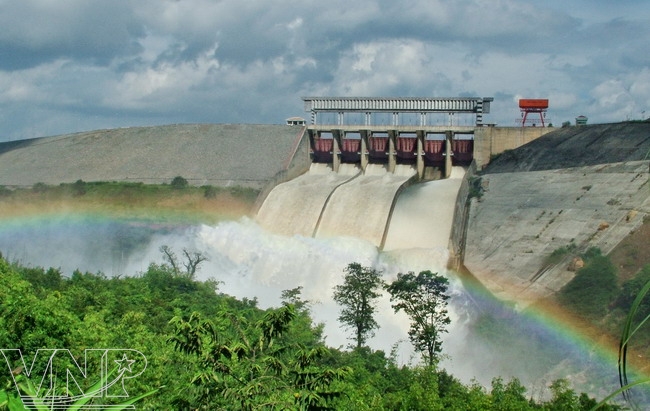The Ialy Hydropower Plant is the largest project on the Se San River and ranks 3rd in the whole country with a total capacity of 720MW and an overage electricity production of 3.68 billion KWh/year.
The Ialy Hydropower Plant, under the Electricity of Vietnam (EVN), was built in 1993 on the Se San River in the district of Chupad in Gia Lai Province and Sa Thay District in Kon Tum Province. After ten years, the plant was put into operation, becoming the largest project in the system of hydropower plants on the Se San River. After the Ialy Hydropower Plant, two hydropower plants, including Se San 3 Hydropower plant and Pleikrong Hydropower plant, were built in 2002 and 2003 with a designed capacity of 260MW and 100MW respectively. Since the plant was put into operation, it has provided the national electricity grid with about 42.6 billion kWh.
 The grandiose beauty of the Ialy Hydropower Plant’s dam during the flood season. Photo: File  The Ialy Hydropower Plant’s reservoir has a capacity of 1.03 billion m3. Photo: Nguyen Luan  The reservoir is the major place providing water for people in the two provinces of Gia Lai and Kon Tum. Photo: File |
| Some awards received by the Ialy Hydropower Company:
-- “The Green Trademark Award - 2008” by the Vietnam Union of Science and Technology Associations.
- “Vietnam’s Top 100 Trademarks - 2008” by the Vietnam Union of Science and Technology Associations. - “Excellent Business in Labor Safety - 2008” by the Ministry of Labour, War Invalids and Social Affairs. - “Top ten WTO Integration Trademarks - 2009” by the Vietnam Union of Science and Technology Associations. - “Gold Cup for the Cause of Environmental Protection EPA - 2009” by the Ministry of National Resources and Environment. |
To meet the demand on the development of the hydroelectric system on the Se San River, EVN turned the Ialy Hydropower Plant into the Ialy Hydropower Company in 2007 with three hydropower plants of Ialy, Se San 3 and Pleikrong with a total capacity of 1,080MW and an average electricity production of 5. 31 billion kWh/year.
According to Ta Van Luan, Director of the Ialy Hydroelectric Company, the effective management and safe operation of three hydropower plants has not only ensured the supply of electricity for economic-socio development and life of people in Tay Nguyen (the Central Highlands), but also contributed to lowering the price of electricity. In 2012, the Ialy Hydropower Company set a record of 5,838 billion kWh (9% higher than the average electricity production/year).
 The operation of the plant is run and controlled by a staff of highly professional engineers. Photo: Nguyen Luan The operation of the plant is run and controlled by a staff of highly professional engineers. Photo: Nguyen Luan The plant’s central control centre. Photo: Nguyen Luan  In 2012, the electricity production of the company set a record of 5,838,000 kWh. Photo: Nguyen Luan  The transformer station of the Ialy Electricity Plant. Photo: Nguyen Luan |
Besides producing electricity, the company has also participated in technical consultancy for several large projects of Vietnam’s leading groups such as Hoang Anh Gia Lai and PetroVietnam. They included the project on experientially refining transformer oil for HaGl-Attapeu Sugar Factory in Laos, experimenting with the electrical insulating oil for over 100 transformers of the Dung Quat Oil Refinery, Doc Cay Hydropower Plant in Thanh Hoa and Hoa Phu Hydropower Plant in Dak Lak…
At present, the company is coordinating with the Power Engineering consulting Joint-Stock Company 1 (PECC1) to complete a report on the project of expanding the Ialy Hydropower Plant with two turbines, each having a capacity of 180MW, increasing the total number of turbines to 6 with a total capacity of 1,080MW.
It is expected that the expansion of the Ialy Hydropower Plant will considerably improve the shortage of electricity in dry season in the Central Highlands and increase the turnover from electricity of 765 billion dong/year.
Besides the electricity potential, the Ialy Hydropower Plant has a large reservoir with an area of 64.5 km2 and a capacity of 1.03 billion m3. The reservoir has become an interesting eco-tourist destination for both domestic and foreign tourists to the Central Highlands. It is also the major place providing water for people in the two provinces of Gia Lai and Kon Tum.
With its great potential and position, the Ialy Hydropower Company will continue contributing to developing the economy, culture and society, improving the lives of people in the Central Highlands and promoting the process of national industrialization and modernization.
Story: Nguyen Vu Thanh Dat - Photos: Nguyen Luan & Files






































 On occasion, Chinese contractors have even accounted for up to 90 per cent of EPC (Engineering/Procurement/Construction) contracts for thermal power plants in the country. Two major factors account for the spectacular rise of Chinese engineering contractors in Vietnam: the conditions attached to the concessional loans and preferential export buyer’s credits that China provides Vietnam, and the ‘flexible’ business strategies of Chinese contractors.
On occasion, Chinese contractors have even accounted for up to 90 per cent of EPC (Engineering/Procurement/Construction) contracts for thermal power plants in the country. Two major factors account for the spectacular rise of Chinese engineering contractors in Vietnam: the conditions attached to the concessional loans and preferential export buyer’s credits that China provides Vietnam, and the ‘flexible’ business strategies of Chinese contractors.